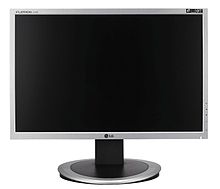This is an old revision of this page, as edited by Yokononos (talk | contribs) at 18:37, 3 September 2012 (→Industry moves away from 16:10 in 2008 to 16:9: speculations). The present address (URL) is a permanent link to this revision, which may differ significantly from the current revision.
Revision as of 18:37, 3 September 2012 by Yokononos (talk | contribs) (→Industry moves away from 16:10 in 2008 to 16:9: speculations)(diff) ← Previous revision | Latest revision (diff) | Newer revision → (diff)
16:10, also known as 8:5, is an aspect ratio mostly used for computer displays. The width of the display is 1.6 times its height.
LCD computer displays using the 16:10 ratio started to appear in the mass market from 2003. By 2008 16:10 had become the most common aspect ratio for LCD monitors and laptop displays. Since 2010, however, 16:9 has become the mainstream standard, driven by the 1080p standard for high definition television.
History
Computer Displays
Industry moves towards 16:10 from 2003 to 2008
Until about 2003, most computer monitors had a 4:3 aspect ratio and some had 5:4. Between 2003 and 2006, monitors with 16:10 (8:5) aspect ratios became commonly available, first in laptops and later also in standalone monitors. Reasons for this transition were productive uses for such monitors, i.e. besides widescreen movie viewing and computer game play, are the word processor display of two standard letter pages side by side, as well as CAD displays of large-size drawings and CAD application menus at the same time.
In 2005-2008, 16:10 took over the position from 4:3 as the most sold aspect ratio for LCD monitors. At the time, 16:10 also had 90 percent of the notebook market and was the most common used aspect ratio for laptops. However, 16:10 had a short reign as the most common aspect ratio.
Industry moves away from 16:10 in 2008 to 16:9
Around 2008-2010, there was a rapid shift by computer display manufacturers to the 16:9 aspect ratio, and by 2011, 16:10 had almost disappeared from new mass market products.
The primary reason for this move is considered to be production efficiency - since display panels for TVs use the 16:9 aspect ratio, it's more efficient for display manufacturers to produce computer display panels in the same aspect ratio as well. A 2008 report by DisplaySearch also cited a number of other reasons, including the ability for PC and monitor manufacturers to expand their product ranges by offering products with wider screens and higher resolutions, helping consumers to more easily adopt such products and "stimulating the growth of the notebook PC and LCD monitor market".
Tablets
| This section needs expansion. You can help by adding to it. (August 2012) |
Tablets started to enjoy mainstream popularity during the late 2000s. These modern releases were initially offered in a 4:3 format, but later releases saw increasing numbers offered in 16:10.
Mobile Phones
| This section needs expansion. You can help by adding to it. (August 2012) |
Towards the end of the 2000s, 16:10 became a feature in certain smartphones. Recently there has been a shift to 16:9, although some phone manufacturers still produce devices in 16:10.
Common screen resolutions of 16:10 screens
| Name | Dimensions | Diagonal screen size |
|---|---|---|
| WXGA | 1280×800 | 13–15 in (33–38 cm) |
| WXGA+ | 1440×900 | 13–19 in (33–48 cm) |
| WSXGA+ | 1680×1050 | 15–22 in (38–56 cm) |
| WUXGA | 1920×1200 | 17–28 in (43–71 cm) |
| WQXGA | 2560×1600 | 30 in (76 cm) |
See also
- Display aspect ratio - Different aspect ratios for computer monitors.
- Aspect ratio (image)
- Computer display standard
References
- Knight, Dan (2008-09-19). "With 10% of the US Notebook Market, Where Will Apple Go Next?".
- ^ "Product Planners and Marketers Must Act Before 16:9 Panels Replace Mainstream 16:10 Notebook PC and Monitor LCD Panels, New DisplaySearch Topical Report Advises". DisplaySearch. 2008-07-01. Retrieved 2011-09-08.
- ^ Ricker, Thomas (2008-07-02). "Widescreen LCDs going widescreen by 2010". Engadget.
- NEMATech Computer Display Standards http://www.millertech.com/Technical_Specs.htm
- "Introduction--Monitor Technology Guide". necdisplay.com. Archived from the original on 2007-03-15. (currently offline)
- Miller, Michael J. (2008-03-21). "Where Displays Are Heading". PC Magazine. Retrieved 2012-07-09.
- Kowaliski, Cyril (2008-07-02). "DisplaySearch: Transition to 16:9 displays is 'unstoppable'". The Tech Report. Retrieved 2012-07-09.